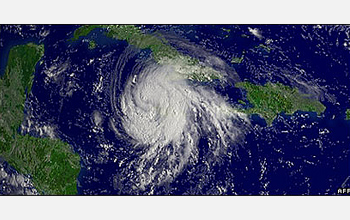

Press Release 08-153
Climate Computer Modeling Heats Up

New "petascale" computer models lead to better understanding of weather-climate links
September 4, 2008
New "petascale" computer models depicting detailed climate dynamics, and building the foundation for the next generation of complex climate models, are in the offing. Researchers at the University of Miami Rosenstiel School of Marine and Atmospheric Science (RSMAS), the National Center for Atmospheric Research (NCAR) in Boulder, Colo., the Center for Ocean-Land-Atmospheric Studies (COLA) in Calverton, Md., and the University of California at Berkeley are using a $1.4 million award from the National Science Foundation (NSF) to generate the new models. The development of powerful supercomputers capable of analyzing decades of data in the blink of an eye marks a technological milestone, say the scientists, capable of bringing comprehensive changes to science, medicine, engineering, and businesses worldwide. The speed of supercomputing is measured in how many calculations can be performed in a given second. Petascale computers can make 1,000,000,000,000,000 calculations per second, a staggeringly high rate even when compared to supercomputers. Although true "peta" processing is currently rare, the anticipated availability of petascale computing offers a golden opportunity for climate scientists to advance Earth system science and help to improve quality of life on the planet, the researchers believe. "The limiting factor to more reliable climate predictions at higher resolution is not scientific ideas, but computational capacity to implement those ideas," said Jay Fein, NSF program director in NSF's Division of Atmospheric Sciences. "This project is an important step forward in providing the most useful scientifically-based climate change information to society for adapting to climate change." Researchers once had assumed that climate can be predicted independently of weather, that is, with weather having no impact on climate prediction. Now they're finding that weather has a profound impact on climate, a result that's integral to the drive to improve weather and climate predictions and climate change projections. With this boost in computing capabilities, research team member Ben Kirtman, a meteorologist at RSMAS, has developed a novel weather and climate modeling strategy, or "interactive ensembles," designed to isolate the interactions between weather and climate. These interactive ensembles for weather and climate modeling are being applied to one of the nation's premier climate change models, NCAR's Community Climate System Model (CCSM), the current operational model used by NOAA's climate forecast system (CFS). The CCSM is also a community model used by hundreds of researchers, and is one of the climate models used in the Nobel Prize-winning International Panel on Climate Change (IPCC) assessments. The research serves as a pilot program to prepare for the implementation of more intense computational systems, which currently remain a scientific and engineering challenge. "This marks the first time that we will have the computational resources available to address these scientific challenges in a comprehensive manner," said Kirtman. "The information from this project will serve as a cornerstone for petascale computing in our field, and help to advance the study of the interactions between weather and climate phenomena on a global scale." While this research focuses on climate science, he said, by-products of the work are applicable to similar modeling challenges in other science and engineering fields, particularly the geosciences. -NSF-

Media Contacts
Cheryl Dybas, NSF (703) 292-7734 cdybas@nsf.gov
Barbra Gonzalez, RSMAS (305) 421-4704 barbgo@rsmas.miami.edu
David Hosansky, NCAR (303) 497-8611 hosansky@ucar.edu
Robert Sanders, UC-Berkeley (510) 643-6998 rsanders@berkeley.edu

The National Science Foundation (NSF) is an independent federal agency that supports fundamental research and education across all fields of science and engineering, with an annual budget of $6.06 billion. NSF funds reach all 50 states through grants to over 1,900 universities and institutions. Each year, NSF receives about 45,000 competitive requests for funding, and makes over 11,500 new funding awards. NSF also awards over $400 million in professional and service contracts yearly.
 Get News Updates by Email Get News Updates by Email
Useful NSF Web Sites:
NSF Home Page: http://www.nsf.gov
NSF News: http://www.nsf.gov/news/
For the News Media: http://www.nsf.gov/news/newsroom.jsp
Science and Engineering Statistics: http://www.nsf.gov/statistics/
Awards Searches: http://www.nsf.gov/awardsearch/
|


